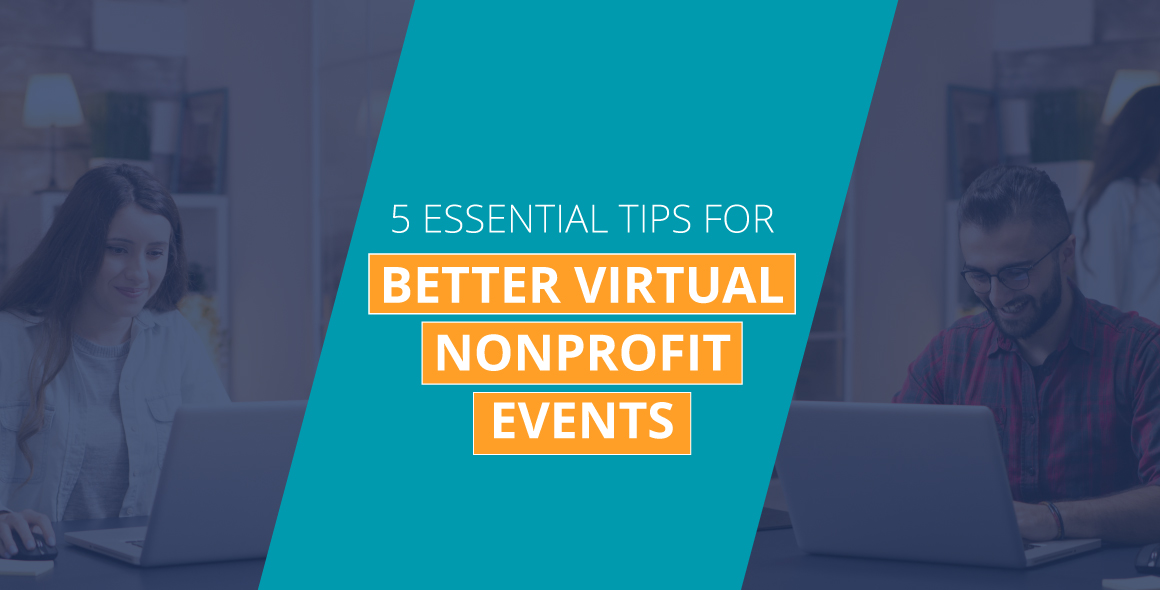Virtual events empower large nonprofits to connect with widespread audiences and drive their fundraising goals forward. However, virtual events pose a variety of challenges, from mastering the technology that powers your events to keeping attendees engaged through a screen.
To overcome these challenges and plan events that leave a lasting impact on your attendees, you need a strong strategy backed by the right best practices. Let’s dive into a few tips to help you plan and host memorable, well-attended virtual events that get results for your mission.
1. Plan meticulously.
Virtual events challenge your team to recreate the engaging and dynamic experience of an in-person event in an online format, which can be difficult to do with all the logistics you have to manage.
To set yourself up for success, you need a thorough event plan. Here are some steps to create one:
- Prepare a detailed budget. Your budget should cover all aspects of your event, from technology costs to speaker fees and beyond.
- Define your event objectives. Outline what you want to accomplish by hosting the virtual event, such as raising awareness, reaching a specific fundraising goal, celebrating a milestone, or building your community.
- Choose the right tools to support your event. Research virtual event software, registration tools, and audience engagement platforms to determine which tools will help you reach your event goals.
- Plan event content and activities. Pre-recorded videos and live entertainment can capture your audience’s attention. Activities like interactive games, online auctions, or breakout sessions can keep them engaged and participating throughout the event.
- Develop a plan for dealing with technical issues. Determine who will be responsible for resolving technical issues and what you’ll do with your audience in the meantime should something go wrong on the day of your event.
Technology is a large part of your virtual event plan. Consider working with a nonprofit technology consultant ahead of time to evaluate your existing event technology stack, select additional tools wisely, and ensure everything is working together to help you achieve your event goals.
2. Design ways to engage your audience.
At an in-person event, it’s easy to keep your audience engaged. Picture a themed fundraising gala. All of your attendees are together in one room enjoying great food, fun games, live entertainment, and interactions with each other.
It’s tricky to get that spirit of interactivity and participation to translate over to a virtual event format, but it is possible. The key is to find easy ways to involve your audience from across the screen that separates you.
Here are a few ideas:
- Live polls: Virtual event software (like Zoom) allows you to launch polls during the event, which you can use for things like asking icebreaker questions or quizzing your audience about your cause.
- Q&A: Invite attendees to submit questions to your speaker or entertainer, giving them a hand in creating the content they want to see during your event.
- Breakout rooms: Split attendees into small groups of 3-5, creating an opportunity for them to get to know one another and chat about your cause or campaign.
- Gamification: Get creative and design a game or two that will pique your attendees’ interest. For example, try a live trivia quiz or virtual bingo game. You can also keep the fun going after the fact or for those who couldn’t attend the event live. For example, encourage supporters to take action on various activities or view recordings of the virtual event to score points and win prizes.
3. Optimize event length and timing.
With virtual events, audience members who feel bored can leave your event with the click of a button. One of the best ways to prevent this is to think through the length and timing of your event.
With in-person events, it is often easier to gauge the temperature of the room and adjust the length of different activities and aspects of the event. You might, for instance, see that your fundraising ball guests are enjoying the dancing portion of the evening and choose to extend that part of your program.
Unfortunately, virtual events don’t offer this luxury. Instead, you need to keep the event short and sweet and ensure that everything moves at a quick pace to hold your attendees’ attention.
Plan out how long you’ll spend on each portion of your event. If you’re having a guest speaker, give them a set amount of time for their talk. Or, if the event involves serving a meal, plan how long each course should take.
Also ensure you know how long each pre-recorded aspect of the event will take, and determine where to intersperse that content so that it breaks up long stretches of talking or helps you avoid lulls in interaction.
Finally, build in a couple of breaks. This will allow your audience (and your team!) to step away from their screens and come back to the event fresh and ready to engage once again.
Another important thing to plan for is recording your event and making that recording accessible to your community of supporters. Even if they can’t attend the live event, many of your supporters may still love to check out the event and review the materials and resources covered.
4. Promote the event effectively.
Once you have all the details of the event itself worked out, it’s time to start promoting the event to your community to ensure a great turnout on the day of. Here are a few tips for doing this successfully:
- Review what you know about your audience. Personalization is key in marketing and helps everyone you invite to your event feel seen and valued. Use your nonprofit’s CRM to review the data you have collected about your nonprofit’s community so that you can ensure your marketing efforts align with their needs and preferences.
- Use a multichannel marketing strategy. The saying “Don’t put all of your eggs in one basket” couldn’t be more true when it comes to marketing. Ensure you’re spreading the word about your event far and wide by using multiple channels. For instance, you might use email, social media, your blog, and text messages to let people know about your event.
- Leverage your branding. Your organization’s brand encompasses everything that makes you stand out from the crowd. Ensure that you’re using the visual aspects of your brand (logo, color scheme, typography, etc.) on your marketing collateral so that your supporters recognize that your event is tied to your cause.
- Communicate the value of attending your event. In your marketing materials, let your community know why you need them at your event. For example, if you need their help funding an important project, say so. Or, if you’re celebrating a prominent community member who has made a significant impact on your cause and want everyone to show their support, be clear about that.
5. Follow up after the event.
After your event is over, there is still work to be done. Specifically, to ensure that your event leaves a lasting impression on all who attended, you need to follow up with them and let them know what their attendance meant to your organization.
Here are some tips for doing so:
- Send out personalized thank-you messages to your attendees, donors, and sponsors.
- Give thank-you letters or small gifts to the special guests (speakers, entertainers, etc.) who made the event possible.
- Send out a recording of the event. This is an excellent way to reach out to supporters who were unable to attend the event live. But you can also send the recording to those who were able to attend so they have the information from the event for their reference. Make sure you let everyone know about upcoming events and opportunities, too.
Also, check in with your nonprofit’s team. Assess your event’s success together and document improvements or adjustments that you could make to future virtual events to strengthen your strategy for the future.
Virtual events are great opportunities to bring your community together, celebrate your cause, and achieve common goals. Use the advice above to host better virtual events that resonate with your supporters.
Remember, the success of your virtual events hinges on how well you can use event technology to engage your audience. Consider working with a nonprofit consulting firm to refine your technology stack ahead of your next event. You can work together to improve how you use your technology stack in other aspects of your operations, too!




